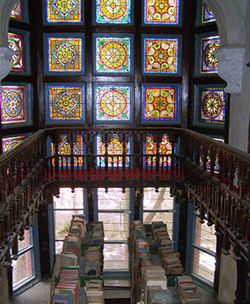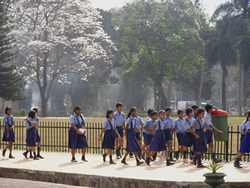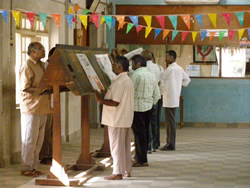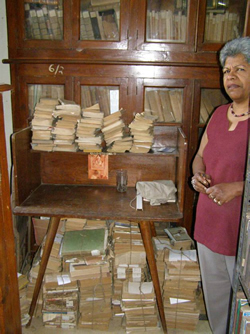By Elizabeth Gould, MLIS
 |
| Elizabeth with kids in Trivandrum. |
A trip to southern India last year gave me the chance to visit libraries of varying sizes and see how they were used by members of diverse communities. Initially I hoped to unearth how various communities accessed information, but when I observed the public libraries, I found they were only accessible to an elite few. I switched gears and focused, instead, on what 'public' meant in this context. My vision of public means 'access to all,' which is an American viewpoint, but in India, it is quite different.
At one end of the spectrum the country can boast of a highly specialized information retrieval system, but at the other end stands the common man who has no access even to basic reading material or advice because of the lack of a public library network spread throughout the length and breadth of this vast country. While there is an 'information flood' in some places, there is an 'information drought' in many others (Banarjee, 1996).
My research evolved into not only visiting libraries and questioning librarians, but also delving into such questions as who uses the library, membership requirements, collection decisions, staffing, computer access and cataloging, literacy rates, and served populations. Further, I questioned each of our 10 local guides about education, literacy, and library usage in each of the seven states that we visited. What I learned is that the Indian government supports both access to education and provides local and regional libraries (Rao, 2001). However, widespread usage of the public libraries was lacking, due in part to restrictive membership requirements. In addition, production of literate library users is inhibited by a tiered education system that is complicated by the multifaceted social/caste system in India.
 |
| Chennai Central Library. |
In 1994 the UNESCO Public Library Manifesto defined a public library as:
the local gateway to knowledge, [and] provides a basic condition for lifelong learning, independent decision-making and cultural development of the individual and social groups.' In this vision of public libraries, they are seen as people-oriented institutions which should service the widest population possible (Ghosh, 2005).
I observed public libraries at multiple levels: a small local library in Kerala, two district central libraries in Madurai and Thanjavur, a state central library in Goa, and national libraries in Chennai and Kolkata, to see how they are serving the public in southern India. My study sites included small coastal villages, large cities, and several libraries in between. I also questioned our local guides in each village or city that we visited, to determine local library use, as well as library membership requirements.
India's population is over one billion, and it is anticipated to become the most populated country in the world overtaking China, by the year 2050 (BBC News, 2004). A multifaceted social and religious caste system creates a complex hierarchy within the society. Estimates range from hundreds to over 1500 different languages, 14 of them official dialects; and at least seven important religions. Although modernization has reached India with the introduction of computer technology, producing a new economic resource through outsourcing, things have not changed for many in the population, particularly within a social context.
Technology is expanding in India. As outsourcing increases, it affects
the Indian economy (Singh, 2005). How is this influx of technology
changing information access? Apparently, this growth is increasing
class divisions as wealthy individuals further educate themselves
and obtain better jobs, which enable them to increase their wealth
(Parvathamma, 2003). Meanwhile, is technology helping the lower classes
obtain information, or is it out of their reach, further separating
them from the more affluent?
India is divided into 28 states and four territories; each one is
divided into smaller districts. Although the literacy rate for each
state is different, all of my guides were proud of the increased literacy
rate in each state. We visited the states of Maharashtra (Mumbai),
Goa, Karnataka (Mangalore), Kerala (Kochi/Cochin), Tamil Nadu (Chennai,
Thanjavur, Madurai), Andhra Pradesh (Visakhapatnam/Vizag), and West
Bengal (Kolkata).
 |
| Schoolchildren in Goa. |
In some areas 'literacy' also includes the ability to do simple addition and subtraction. This devalues the term literacy. Other caveats for reporting literacy statistics are the rapidly expanding population, infrequent censusing, and vast numbers of homeless or transient who are often neither censused nor literate. For instance, 25% of the population live below the poverty line (2002 estimate, CIA Factbook, 2007), and 30% of urban populations live in shanty towns (Kim Saunders, 2007).
The government of India has taken great strides in the past few years to increase the literacy rate by introducing incentives such as offering free lunches for all students. In some states such as Goa, the literacy rate of females is significantly lower than males. To encourage girls to attend school the state offers girls bicycles upon their graduation from the 8th grade; it is hoped they will use them to commute to school for higher education. Unfortunately, education is still subjugated by a strong cultural influence that girls need to learn how to cook and do domestic chores well, so that they are prepared to become good wives. 95% of Indian marriages are still arranged by parents or families (Kim Saunders, 2007). Only 48.3% of females are literate, compared to 70.2% of the males (CIA World Factbook, 2007).
These figures prompted me to ask if libraries in India help promote education and access to information. Have libraries realized that information must to be accessible to all classes and castes? Is the government supporting this goal?. 'We the information professionals need to come forward and study the present system of operation and find a better solution to transform straightforward reading rooms into an information/knowledge centre where people, weighed down by illiteracy or limited education, find value' (Ghosh, 2005)
I was interested to see how libraries supported the lower income communities, and if innovations such as computers and information kiosks were available. In the regions that I visited, schools and libraries utilize computers on a very limited basis. Computer classes are taught only in private schools. The largest national libraries use computers, but the public has extremely limited access to the computerized catalog, which is available only in the large national libraries.
 |
| Reading room in Madurai. |
Where does this lead us in terms of the 'public' and educating them to use computers with access for all? 'As a consequence of making education a fundamental right, free, unhindered, easy access to books and libraries also becomes essential and should be ensured' (Ghosh, 2005). Clearly this is not a priority for the government of India, although a commendable base has been established with universal access to education (although not compulsory), strides towards increased literacy, and a system of regional and district libraries. Resources and trained library professionals were insufficient. Books do not get processed. Membership charges exclude potential users and do not generate significant income for individual libraries. Only the major state libraries have computerized catalogs. Only some of the largest repository libraries offer computer access to the internet, and it's for a fee.
Where is the computer training to come from once a student steps out of school, if they get it at all? After visiting a variety of schools, it was clear the government does not support computer training in its schools; only private schools can afford this luxury. This creates a further divide as illiteracy exacerbates poverty (Nikam et al, 2004). Only people who can afford private education learn to use computers, and as computer usage becomes more prevalent worldwide, the poor become poorer and less informed, while the wealthier are trained and often leave their impoverished countries to find technology jobs in more affluent and technologically advanced countries (Parishwad, 2002).
 |
| Goa library. |
We are fooled into believing that technology has penetrated into Indian society by the large access we have to outsourced information. Clearly the poor remain so, and the middle class is divided by lack of access to information. It is encouraging to note that the Indian government is supporting schooling and teaching children to learn to write their names (in hopes that they will eventually have access to libraries?), but the social stratification that is required by membership referrals discourages access to libraries, where information resources are abundant. Much progress can be seen in available resources for the academic and research communities, but progress needs to be made 'from technology that supports the library staff to technology that empowers the library user' (Rao, 2001).
In a more equitable world, resources could be directed towards more uniform access to information by making libraries more inviting and accessible, and developing local content in a language that the poor can understand (Nikam et al, 2004). This ambition is inhibited by a firmly ingrained social class system, thus the government needs to lead the way by truly making the libraries accessible to all.
These goals could be achieved by changing the mindset at the policy-making level and focusing on education. In the twenty-first century, India should look upon education as a key infrastructure for economic development. What remains to be seen is how establishing these facilities will benefit and improve the socio-economic conditions of India's citizens, allowing the nation to emerge as an economic superpower in the next century (Rao, 2001). The public library in India is considered to be a living force for education, culture, and information and seen as an essential agent for the fostering of peace and spiritual welfare through the minds of men and women. The library movement in India is now eighty-five years old; yet in spite of that duration, except for ten states, library is not in operation to provide 'free book service for all' (Banarjee, 1996).
REFERENCES
Banarjee, Dw arika N. (1996). The story of libraries in India. Daedalus, 125, 4, 353-362.
BBC News. (2004, August 18). India population 'to be biggest.' Retrieved March 3, 2007, from http://news.bbc.co.uk/1/hi/world/3575994.stm.
CIA World Factbook. (2007). Retrieved March 3, 2007, from https://www.cia.gov/cia/publications/factbook/.
Ghosh, Maitrayee. (2005). The public library system in India: challenges and opportunities. Library Review, 54, 3, 180-192.
Ghosh, Maitrayee, et al. (2006). Strategic cooperation and consortia building for Indian libraries: models and methods. Library Review, 55, 9, 608.
Nikam, Khaiser, et al. (2004). The changing face of India. Part I: bridging the digital divide. Library Review, 53, 3/4, 213-223.
Parishwad, Rajesh. (2007, January 28). The hunt is on: MBA placements: Premier institutes are sporting for choice; the lesser ones bask in their shadow. The Week, 45-53.
Parvathamma, N. (2003). Digital divide in India: Need for correcting urban bias. Information Technology and Libraries, 22, 1, 35-39,
Rao, Siriginidi Subba. (2001). Networking of libraries and information centres: Challenges in India. Library Hi Tech, 19, 2, 167-179.
Saunders, Kim Jane. (2007). Author and Research Associate, University of North London. Personal communication, February 2007.
Singh, Shashi Prabha. (2005). The role of technology in the emergence of the information society in India. The Electronic Library, 23, 6, 678-691.
Wikipedia, Literacy in India, Retrieved March 3, 2007, from, http://en.wikipedia.org/wiki/Literacy_in_India.
